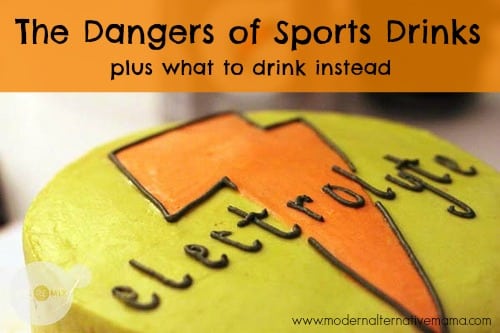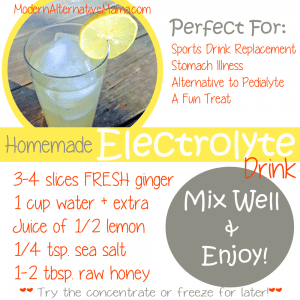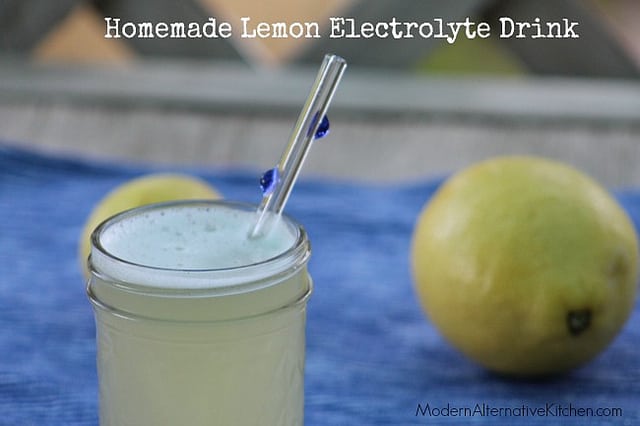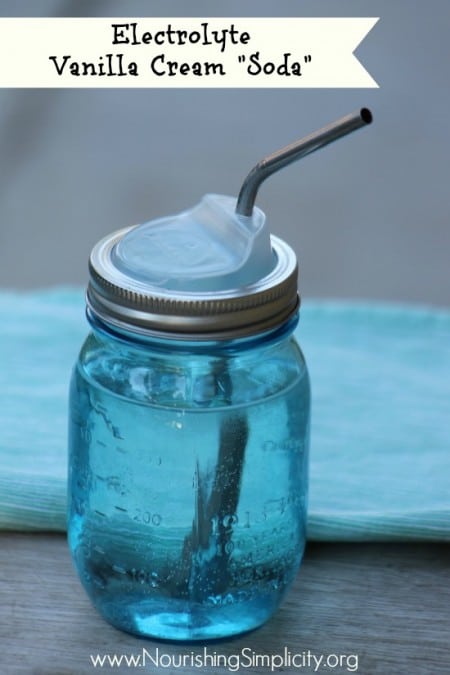Photo Credit: michelle.schrank
It’s a hot summer day. Your little man just got done with his tee-ball game and what does the mom who brought snacks hand out? A sports drink! Those boys have been playing hard, so of course they need a little pick-me-up.
Inwardly, I cringe whenever I see someone, especially a child, guzzle down a sports or electrolyte drink. It maybe rehydrating their bodies and balancing out their electrolytes, but it is also a toxic chemical cocktail ready to do harm to the body. There are many dangers of sports drinks!
What’s In Sports Drinks
Take a look at the ingredient list in Gatorade Thirst Quencher Orange:
WATER, SUGAR, DEXTROSE, CITRIC ACID, NATURAL FLAVOR, SALT, SODIUM CITRATE, MONOPOTASSIUM PHOSPHATE, GUM ARABIC, SUCROSE ACETATE ISOBUTYRATE, GLYCEROL ESTER OF ROSIN, YELLOW 6
This is what most sports and electrolyte drinks (including Pedialyte) look like — some worse, some a little better. Here is a breakdown on the ingredient list, why they are used and how they affect your body.
Sugar
Too much sugar isn’t good for anyone, especially when it is striped of all its minerals (which is true of most sugar). Frequently, companies are using genetically modified sugar beets to make sugar found in drinks. It can overload your liver, decay teeth, cause insulin resistance, which can lead to Type 2 diabetes. Sugar is also highly addictive, among other things.
Dextrose
Dextrose (also know as glucose) is used in medical applications when a patient is unable to consume enough liquids. It is also used as an artificial sweetener in foods. Excessive use of dextrose been linked to obesity, diabetes, high blood sugar (hyperglycemia) and lack of sodium in the blood. Other side effects may occur as well.
Citric Acid
Citric acid is used as a preservative, as well as an acidic or sour taste in foods. It can actually be harmful if you have a history of electrolyte/mineral imbalances. To learn more about the scary side effects read here. (Note: this pertains more to those who use citric acid as a supplement or medicine but still something to keep in mind.)
MSG can be found hidden in citric acid. Known side effects of MSG are:
- Headache
- Flushing
- Sweating
- Facial pressure or tightness
- Numbness, tingling or burning in the face, neck and other areas
- Rapid, fluttering heartbeats (heart palpitations)
- Chest pain
- Nausea
Natural Flavor
Natural flavor is anything but natural. When you hear natural, you automatically think, “Hum, it’s natural, so if must be good for me.” Far from the truth, my friends! Natural flavor is a substance that has been derived directly from a natural item. It can be sourced from vegetables, fruits, meats, spices and dairy products. So far, so good, right?
Here’s the thing — the substance is extracted, then chemically altered to taste like it would have before it was modified. Many times, the flavor that was extracted has nothing to do with the food it was used in. One example would be castoreum — it is the natural flavor used in things like raspberry and vanilla ice cream, and it is derived from the anal glands of a beaver (if you see “vanillin” on the label — you’re eating beaver anal secretions!). Other hidden things like MSG can be found in “natural flavor.”
Under the Code of Federal Regulations, the definition for natural flavor is: “the essential oil, oleoresin, essence or extractive, protein hydrolysate, distillate, or any product of roasting, heating or enzymolysis, which contains the flavoring constituents derived from a spice, fruit or fruit juice, vegetable or vegetable juice, edible yeast, herb, bark, bud, root, leaf or similar plant material, meat, seafood, poultry, eggs, dairy products, or fermentation products thereof, whose significant function in food is flavoring rather than nutritional” (21CFR101.22).
Salt
Salt is extremely important for your body and it is one of the most important ingredients in electrolyte drinks. Sadly, your typical table salt (umbrella popping into anyone’s mind?) is far from how God created it. Truly natural, good-for-you salt is “dirty” in appearance (i.e. not pure white). It is not chemically “cleaned” to become the white crystals we now think of as salt. The process involves uses of aluminum, ferroan-cyanide and bleach. All of its minerals are removed. When the minerals are intact they can actually help balance blood pressure. See more below about healthy salt!
Sodium Citrate
Sodium Citrate is the sodium salt of citric acid. It is what gives drinks their salty and sour taste. It is sometimes used to regulate acid in drinks. It is also used as an emulsifier for oils when making cheese (think American Cheese), allowing the cheese to melt without becoming greasy. It is often used for flavor or as a preservative. It emulsifies the oils with the water that are sometimes added to drinks. There are scary side effects that include loose stools, nausea, upset stomach and vomiting.
Monopotassium Phosphate
Monopotassium phosphate (potassium dihydrogen phosphate, KDP, or monobasic potassium phosphate) is a source of potassium that is used as a food additive to emulsify oils and liquids that would otherwise separate. It additionally acts as a thickener, acidity regulator and stabilizer. It is also used as fertilizer and fungicide.
Gum Arabic
Gum arabic is made from the hardened sap of two species of the acacia tree. It is used as a thickening agent and as an emulsifier — it binds the sugar into the drink. There is question as to whether it is a sustainably harvested product.
Sucrose Acetate Isobutyrate
Sucrose Acetate Isobtyrate is an emulsifier and a weighing agent by adding density to beverages. It is now being used instead of brominated vegetable oil. It is an unnatural sugar (sucrose). In one study, it was shown to increase the liver size in dogs.
Glycerol Ester of Rosin
Glycerol Ester of Rosin is an emulsifier and can be used as an alternative to brominated vegetable oil in citrus-flavored drinks. It gives a more authentic flavor to fruit-flavored water-based drinks. It has been found, in rare cases, to cause allergic reactions.
Yellow 6
Yellow 6 food dye has been linked to learning and concentration disorders in children. It can aggravate ADHD symptoms. There are also animal studies that demonstrates potential risk such as kidney and intestinal tumors. In the UK, companies are required to label foods containing it with warning labels!
What to Drink Now?
There are many amazing alternatives that are easy to find or make.
Coconut Water
Coconut water is the liquid that is found inside the coconut (not to be confused with coconut milk, which is made from the meat). It is the perfect balance of electrolytes that your body needs. It has actually been nicknamed “Nature’s Gatorade.” It contains 5 important electrolytes:
- Potassium: The most important positive ion (cation) inside your cells; potassium regulates heartbeat and muscle function. Coconut water contains 295 mg, which is 15 times the amount in the average sports drink
- Sodium: The most important positive ion in fluid outside your cells, and also the one most depleted with exercise, as you lose sodium through sweat and urine
- Magnesium: Important for maintaining the electrical potential of your cells, proper muscle function, and preventing calcium overload
- Phosphorus: Plays important roles in bone health, but also in transferring energy throughout your body, helping your muscles contract, and regulating nerve function (partners with calcium)
- Calcium: Important for bone health (partners with phosphorous) (Source http://mercola.com)
Coconut water can be used as an electrolyte on its own or it can be added to homemade electrolyte drinks.
Real Salt
Real Salt from Redmond is my favorite source of electrolytes. I use it my own homemade lemon sports drink. Where as regular table salt has been chemically washed, striped it of all its mineral, Real Salt, contains 60 trace minerals, non have been striped. These minerals included:
- Sodium
- Calcium
- Potassium
- Sulphur
- Magnesium
- Iron
- Phosphorus
- Iodine
- Manganese
- Copper
- Zinc
You can buy their Re-lyte capsules, add a pinch of salt to your water (not my idea of a tasty drink) or use the salt in your homemade electrolyte drinks!
When you use products straight from nature like coconut water and Real Salt you are giving your body what is needs without bringing any harm to your body. You won’t experience the same effects from using either of these products, you will be experience better effects! Your body doesn’t have to sort through the toxic chemicals to make use of the minerals like it does with store-bought sports drinks, instead your body get’s them exactly how God created them. I for one find it so cool that He creates just what we need without having to use artificial ingredients.
Are you ready to give making your own sports drinks a try? Here are some recipes to get you started!
- Electrolyte Concentrate Ice Cubes @ Modern Alternative Mama
- Electrolyte Drink (Sports Drink Replacement) @ Modern Alternative Mama
- Refreshing Orange Lemonade @ The Nourishing Gourmet
- Honeydew Lime Electrolyte Drink @ The Nourishing Gourmet
- Watermelon Coconut Electrolyte Drink @ An Appetite for Joy
- 6 Electrolyte Drinks @ The Herbal Trading Post
- Vintage Remedies Homemade Electrolyte Drink @ Holistic Homemaking
- Dehydration Aid @ Hybrid Rasta Mama
- Electrolyte Vanilla Cream “Soda” @ Nourishing Simplicity






If you want to drink a sports drink that’s actually made with natural ingredients we sell pure sports hydration in New Zealand and Australia. It’s made with real fruit, electrolytes and carbs.
I didnt know that they were bad for you my gson HAS BEEN DRINKING THEM FOR A LONG TIME HE HAS BEEN PLAYING SPORTS SINCE FIRST GRADE NOW A SOPHMORE AND THATS ALL WE HAVE GAVE HIM GOT NEW COACH LAST YEAR AND STOP DRINKING GAD AND START DRINKING POWER ADE BECAUSE COACH SAID THAT ONE WAS BETTER FOR YOU THAN THE OTHER ALSO PLAYERS NOT ALOUD TO DRINK SODAS PLEASE SEND ME SOME RECIPES TO MAKE FOR PLAYERS THANKS FOR IN FO
For many years the UNICEF and other international aid organizations have promoted re-hydration therapy for people, especially children, suffering from de-hydration due to the flu and diarrhea. Oral Rehydration Solutions can be made at home with 6 level teaspoons of sugar and 1/2 level teaspoon of salt dissolved in 1 litre of clean water. This sort of solution may also be helpful in cases of dehydration due to exertion, exercise, etc.
I put the ingredients for the electrolyte drink in my vitamix and then served. All the kids rejected it saying it was too spicy. Would it work as well with less or no ginger?
Oh my word, vanillin is NOT sourced from beaver anal glands my word
LOL yes, Justin, it is. Do a quick search and you’ll find that it’s true!
Vanillin isn’t great, but in food products it’s normally the kind derived from wood sources. The whole point is a cheap alternative to real vanilla so the animal source would be too costly for anything but cosmetic uses (i.e. perfumes). Paper by-product versions are inherently more plentiful and less expensive.
https://explore.globalhealing.com/vanillin/
https://www.snopes.com/fact-check/castoreum/
I noticed this seems more based on the gatorade and Powerade drinks; what about Body Armour? Could you break that down? It says they’re mostly coconut water so I’d be curious if the other stuff in there. Thank you!
Hi Nicole! Body Armor seems better on the outside, but does have some pitfalls. It lists “natural flavors” which cannot be determined on that name alone, plus it uses a lot of added synthetic and isolated vitamins. These cannot only upset balance in the body, but also sometimes like in the case of Folic Acid, cause harm for some people (those with MTHFR). It also has large amounts of citric acid. Sounds harmless, but most of the time citric acid is not derived from citrus but from Aspergillus niger (aka black mold). It does have a lot less sugar and is better than gatorade for certain! I like to use a powder mix from Earthley made with organic maple sugar, cream of tartar, and Himalayan pink sea salt. https://earthley.com/product/electrolyte-powder/ref/modernamama